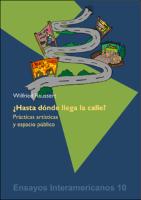¿Hasta dónde llega la calle?
Prácticas artísticas y espacio público
Author(s)
Raussert, Wilfried
Contributor(s)
Raussert, Wilfried (editor)
Kaltmeier, Olaf (editor)
Language
SpanishAbstract
Spurred by a new wave of protests around the world - from the Occupy movement, Black Lives Matter, the Arab Spring, and the various street marches against neoliberal governments throughout Latin America - Raussert examines how artistic practices in the Americas have challenged the control of public space in relation to gender, race, sexuality, class, and age in three periods (the 1920s and 1930s, the 1960s and 1970s, and the new millennium). This inter-American perspective sheds light on common utopian aspirations across time and space, as in the networked movements of indigenous, African-descended and the diasporic groups, epitomized by the Zapatista slogan: “Mientras los medios de comunicación sigan mintiendo, las paredes seguirán hablando” (As long as the media continues to lie, the walls will continue to talk). Indeed, this must-read book shows how contesting artists subvert the increasing privatization, consumerization and electronic monitoring of public space and its virtualization in the new media in our own time period. | George Yúdice (Professor of Latin American Studies and Modern Literature at the University of Miami, U.S.A.)
Keywords
Public space, artistic practices, street art, the social, the AmericasDOI
10.4119/unibi/2943634ISBN
9783946507598, 9783946507604Publisher
Kipu-VerlagPublisher website
https://www.uni-bielefeld.de/einrichtungen/cias/publikationen/kipu/Publication date and place
Bielefeld, 2020Series
Ensayos InterAmericanos, 10Classification
Other graphic or visual art forms
History of the Americas
Pressure groups, protest movements and non-violent action


 Download
Download